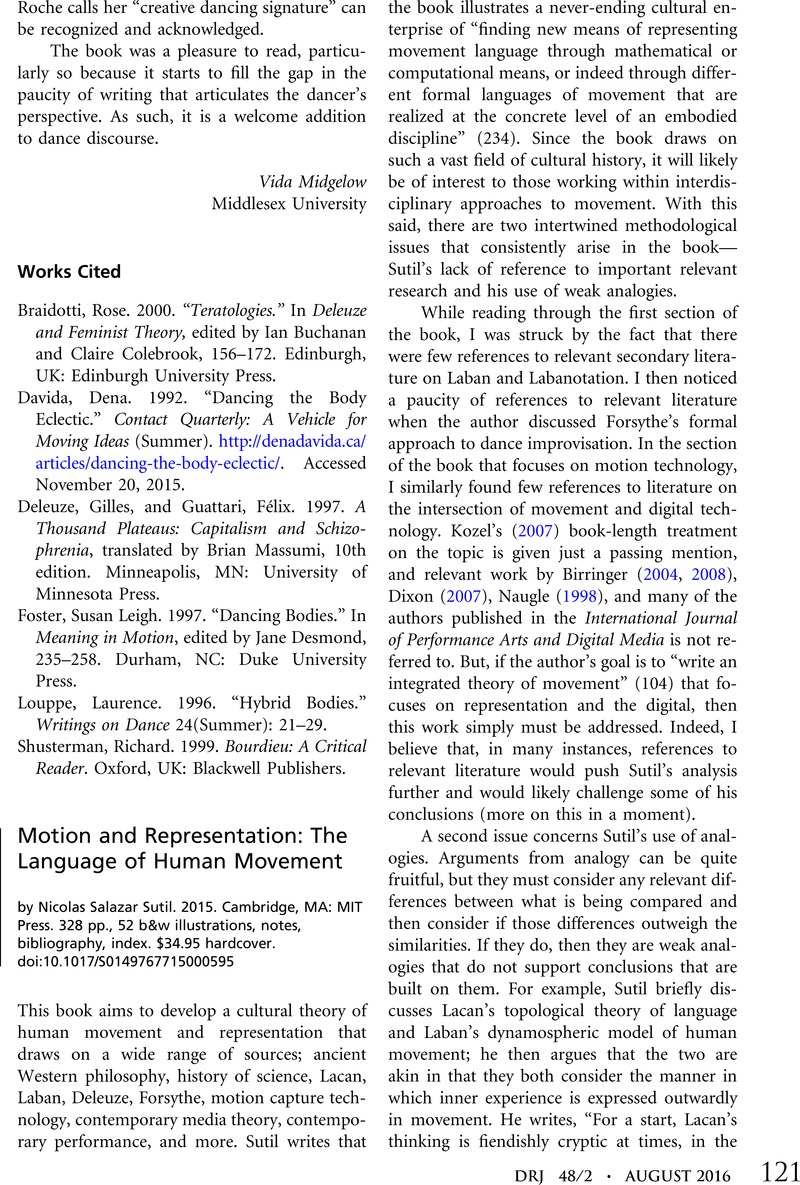No CrossRef data available.
Article contents
Motion and Representation: The Language of Human Movement by Nicolas Salazar Sutil . 2015. Cambridge, MA: MIT Press. 328 pp., 52 b&w illustrations, notes, bibliography, index. $34.95 hardcover.
Review products
Motion and Representation: The Language of Human Movement by Nicolas Salazar Sutil . 2015. Cambridge, MA: MIT Press. 328 pp., 52 b&w illustrations, notes, bibliography, index. $34.95 hardcover.
Published online by Cambridge University Press: 18 August 2016
Abstract
An abstract is not available for this content so a preview has been provided. Please use the Get access link above for information on how to access this content.

- Type
- Book Reviews
- Information
- Copyright
- Copyright © Congress on Research in Dance 2016
References
Works Cited
Birringer, Johannes. 2004. “Dance and Interactivity.” Dance Research Journal
35(2): 88–111.CrossRefGoogle Scholar
Birringer, Johannes. 2008. “After Choreography.” Performance Research
13(1): 118–122.CrossRefGoogle Scholar
DeLahunta, Scott. 2002a. “Software for Dancers: Coding Forms.” Performance Research
7(2): 97–102.Google Scholar
DeLahunta, Scott. 2002b. “Virtual Reality and Performance.” Performing Arts Journal
24(1): 105–114.Google Scholar
DeLahunta, Scott, Clarke, Gill, and Barnard, Phil. 2012. “A Conversation about Choreographic Thinking Tools.” Journal of Dance and Somatic Practices
3(1–2): 243–259.Google Scholar
Dixon, Steve. (2007). Digital Performance: A History of New Media in Theater, Dance, Performance Art, and Installation. Cambridge: MIT Press.CrossRefGoogle Scholar
Hansen, Mark B. N.
2006. Bodies in Code: Interfaces with Digital Media. New York: Routledge.Google Scholar
Hayles, Katherine N.
1999. How We Became Posthuman: Virtual Bodies in Cybernetics, Literature, and Informatics. Chicago: University of Chicago Press.CrossRefGoogle Scholar
Kozel, Susan. 2007. Closer: Performance, Technologies, Phenomenology. Cambridge, MA: MIT Press.Google Scholar
Lakoff, George, and Johnson, Mark. 2003. Metaphors We Live By. Chicago: University of Chicago Press.CrossRefGoogle Scholar
Protopapa, Efrosini. 2013. “Choreography as Philosophy, or Exercising Thought in Performance.” In Thinking Through Dance: The Philosophy of Dance Performance and Practices, edited by Bunker, Jenny, Pakes, Anna, and Rowell, Bonnie. Hampshire, UK: Dance Books.Google Scholar
Rosenberg, Susan. 2012. “Trisha Brown's ‘Water Motor’ Forever, Now, and Again.” The Drama Review
56(1): 150–157.CrossRefGoogle Scholar
Spier, Steven. 2011. “Choreographic Thinking and Amateur Bodies.” In William Forsythe and the Practice of Choreography, edited by Spier, Steven, 139–150. New York: Routledge.Google Scholar




